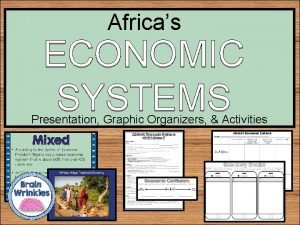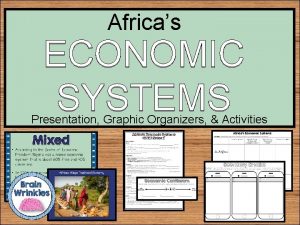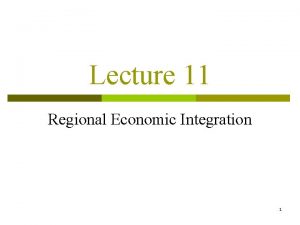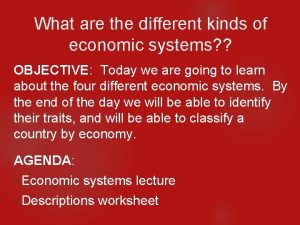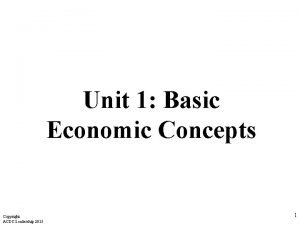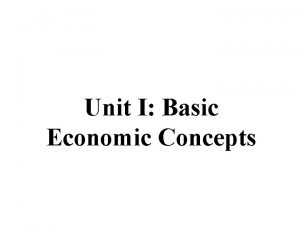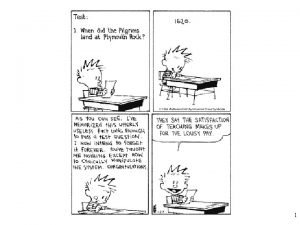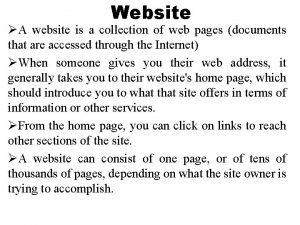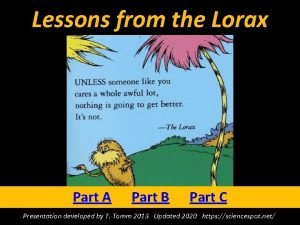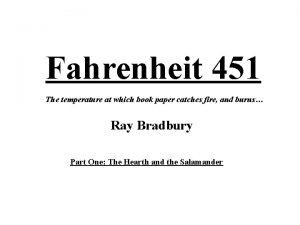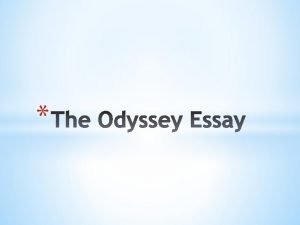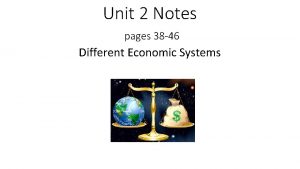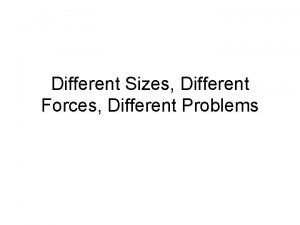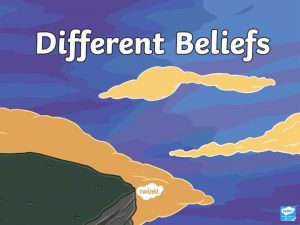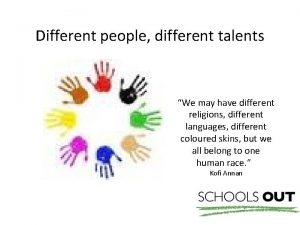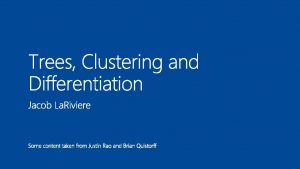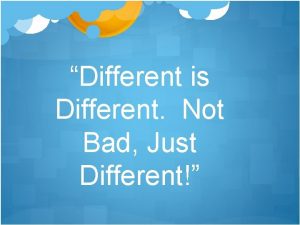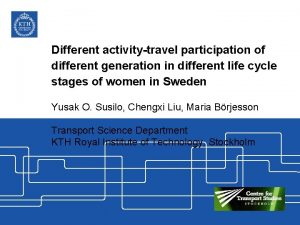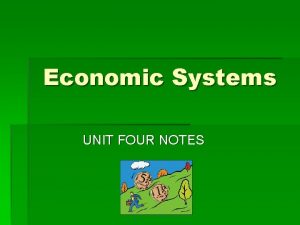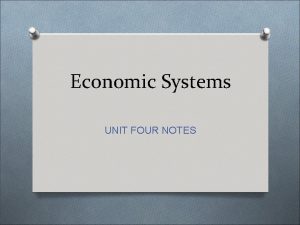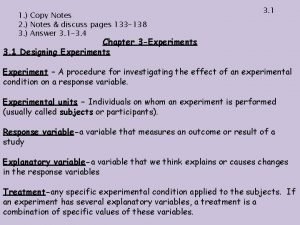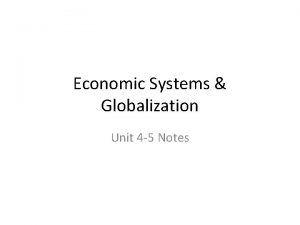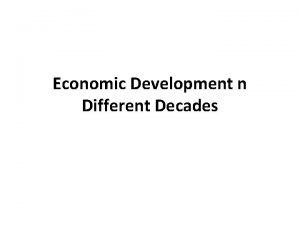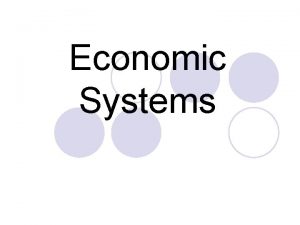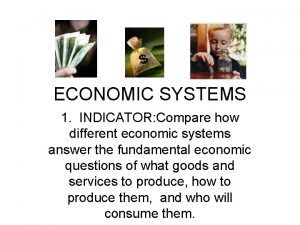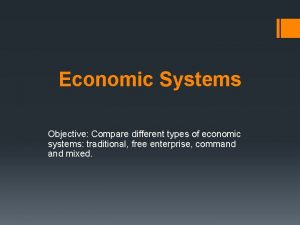Unit 2 Notes pages 38 46 Different Economic


































- Slides: 34

Unit 2 Notes pages 38 -46 Different Economic Systems

Vocabulary for Chapter 2 -1 1. TRADITIONAL ECONOMY __________________ The use of economic resources and all economic decisions are made out of ritual, habit and custom. 2. ECONOMIC SYSTEM _______________ The organized way a society provides for the wants and needs of its people. How the society is dealing with scarcity. 3. COMMAND ECONOMY _______________ A central authority makes most of the economic decisions 4. SOCIALISM _______________ The government owns some factors of production and has some role in determining what goods and services are produced. 5. MARKET _______________ A location or other mechanism where buyers and sellers interact to exchange goods and services for payment of some kind. 6. MARKET ECONOMY _______________ The major economic questions are answered by the people who make the supply and demand decisions in their own best interest. 7. CAPITALISM _______________ Private individuals own and use the factors of production for their own profit or gain

Chapter 2 -2: Mixed Economies Vocabulary MIXED ECONOMIES 8. ___________Economic system that has some combination of traditional, command market economy features; also modified free enterprise system GREAT DEPRESSION 9. ___________Worst period of economic decline in United States history, lasting approximately from 1929 to 1939. COMMUNISM 10. ___________ Economic and political system in which factors of production are owned and directed by the state; based on a theoretically classless society in which everyone works for the common good.

Vocabulary Chapter 2 -3 GDP per capita 11. ___________ Gross domestic product on a person basis; can be expressed in dollars and cents Privatization 12. ___________Conversion of state owned factories and other property into private ownership Vouchers 13. ___________ Certificates that could be used to purchase government owned property during privatization Five-Year plan 14___________ A comprehensive, centralized plan used by the soviet union and China to coordinate development of agriculture and industry. Gosplan 15. ___________ Central planning authority in the former soviet union that devised and directed the Five Year Plan.

Collectivization 16. ___________ The forced common ownership of the factors of production; used in the former Soviet Union in agriculture and manufacturing 17. Perestroika ___________ Fundamental restructuring of the Soviet economy; an economic policy introduced by Mikhail Gorbachev Leap Forward 18. Great ___________ China’s second Five-Year Plan, begun in 1958, which forced collectivization of agriculture and rapid industrialization. Isolationism 19. ___________ National policy of avoiding international alliances and economic interactions

Nationalization 20. ___________ Shift of an economy, or part of an economy, from private ownership to government ownership Solidarity 21. ___________ Independent Polish labor union founded in 1980 by Lech Walesa. European Union (EU) A confederacy of European 22. ___________ countries created in 1993, to develop a single market with full economic and political cooperation. Black Market 23. ___________ Market in which illegal goods and services are bought and sold

Capital Intensive 24. ___________ Production process requiring large amounts of capital instead of labor Keiretsu 25. ___________ Independently owned group of Japanese firms joined and governed by an external board of directors in order to regulate competition. Population Density Number of people per square 26. ___________ mile

Three Types of Economic Systems An economic system is the way a society has chosen to deal with the question of scarcity There are lots of different systems, but most can be grouped into three main categories: • TRADITIONAL • COMMAND • MARKET

TRADITIONAL ECONOMY • Decisions based on habit, custom and ritual • Usually tribal • Individuals not free to make decisions based on their wants • Decisions are made by honoring customs of elders or ancestors EXAMPLE: New Zealand Maori, Early Native American tribes, Ancient Aztec ONE ADVANTAGE: No uncertainty. Everybody knows what their place is in the community and what job they will do ONE DISADVANTAGE: Low standard of living and economic stagnation

COMMAND ECONOMY AND SOCIALISM • A central authority makes all of the major economic decisions • The most common form of command economy is SOCIALISM. • Socialism is an economic and political system in which the government owns some, but not all, the factors of production. • Socialist governments play a big part in deciding WHAT, HOW and FOR WHOM to produce

Command Socialist • Decisions are made “for the people” instead of “by the people” • Often the central government is corrupt and keeps the country’s wealth to benefit the leader and his “cronies” • Workers have little incentive to make good quality products • Quota system

COMMAND ECONOMIES AND SOCIALISM EXAMPLES: • North Korea • The former Soviet Union • Cuba, Vietnam, Venezuela ONE ADVANTAGE: Command economies can change direction drastically • Soviet Union in 1910 ONE DISADVANTAGE: Very little personal freedom or private property rights

Communist or Socialist? A. “Communist” economies 1. Karl Marx – father of Communism 2. Socialism and communism born out of the horrors of the industrial revolution 3. Capitalist business owners abused and exploited workers B. Features of Communism 1. Classless society – NO PRIVATE PROPERTY OWNERSHIP 2. No government 3. Work according to capability – receive according to need 4. Ideal society 5. Everyone works for the common good 6. Workers would benefit most from this system

C. Reality of Communism A. Exploited workers as badly as capitalism B. Corrupt C. Socialism was supposed to be a stepping stone to ideal of Communism; in reality, the government owns and directs all factors of production. D. NO PRIVATE PROPERTY/NO PROFITS/NO INCENTIVES E. Doesn’t meet the needs of people in a world of limited resources and unlimited wants and needs F. True Communism has never existed G. All “Communist” governments/economies are really Socialist • Government control of industries • Government owns and directs the use of factors of production

MARKET ECONOMY AND CAPITALISM • WHAT, HOW and FOR WHOM questions are answered by business owners and consumers • Lots of freedom to choose • Private ownership of property • Consumer dollars = votes for products • Market Economies are associated with CAPITALISM – a system where private citizens own the factors of production for their own profit or gain

MARKET ECONOMY and CAPITALISM EXAMPLES: Hong Kong, Singapore (most Capitalist) ONE ADVANTAGE: A high degree of individual freedom and choice DISADVANTAGES: PURE CAPITALIST systems don’t provide for everyone’s needs and wants. (Great Depression) Some people are too old, young, sick to be able to participate. That’s when charities and the government get involved and the economy ceases to be pure capitalist. Also there is a high degree of uncertainty: people get fired, businesses fail, etc. NOTE: there are NO purely capitalist countries in the world. All have some degree of government involvement.

What Are Mixed Economies? • The most common economic system today is the Mixed Economy • Most economic systems today are made up of features from two or more types. A. Why do mixed economies exist? 1. People from one type of economy come in to contact with people, products or technology from other cultures and economies. They want what other people have. 2. People want more social benefits than any one type of economy can provide 3. Sometimes change occurs when people are unhappy with the way things are going economically. The Great Depression caused people to want some of the social safety nets(unemployment, minimum wages, bank deposit insurance), that had been missing prior to that time. They were NOT moving away from capitalism but they wanted social programs to work within the capitalist framework. )

B. WHAT, HOW and FOR WHOM Decisions 1. Political parties, government systems, economic systems can confuse things 2. What the economic mixture a country has depends on how much government involvement exists in the economy. 3. The amount of government involvement in the economy can vary 4. The more socialist a government is, the more control the government has of the economy (Mixed Socialist) 5. The more market oriented or capitalist a government is, the less control they exert over the economy (Mixed Market)

C. Economic Spectrum 1. Mixed can be Socialist/Command mixed with a few Free Market characteristics or it can be Free Market with a few Command characteristics 2. Some degree of personal choice and private property ownership exists with varying degrees of government involvement to provide for the needs of the people North Korea CUBA CHINA UK Mixed Market/Capitalist with some Command characteristics USA KONG Most Market Most Command Mixed Socialist/Command with some Market characteristics FRANCE HONG

B. Mixed Socialism 1. Marx said Socialism was the political and economic system necessary for a country to reach Communism 2. There a number of mixed socialist countries today: A. North Korea is similar to the former USSR – very much a command economy where resources are controlled to “provide for the people” but really only provide for the leadership. B. Cuba, while still a command economy, is opening up more and more to Capitalist ideas and considering market reforms C. Most Socialist/Communist countries are embracing limited market modifications D. Venezuela went the other way: getting rid of Capitalist policies in favor of more Socialist ideals when Pres. Hugo Chavez nationalized most of the major industries. (isn’t working well for them)

C. Mixed Markets 1. There are more Mixed Market economies than any other kind 2. The Capitalist ideas of profit and personal advancement coexist with programs, like Medicaid, welfare, unemployment and disability insurance that are considered to be more Socialist in nature 3. In most Mixed Markets, social programs are paid for through a variety of taxes 4. Mixed Markets tend to do well in democratic countries where people influence the make up of the government and the economy by voting for candidates and economic policies like those that help the less fortunate.

Examples of Mixed Markets A. Denmark, Germany and France are considered Mixed Markets because of the number of social programs they offer, paid for by taxes on citizens B. In Norway, the government owns the basic petroleum industry and uses the profits to pay for programs like education, roads and health care for its citizens C. Sweden was known as the "Socialist state that works. ” However, the citizens objected to the high taxes that went to pay for social programs D. China is an anomaly. It could be described as Mixed Socialist or Mixed market. It’s government considers itself to be Communist. They tend to be very traditional in rural areas but have embraced some market reforms in the larger cities to encourage economic growth. E. United States has some traditional elements and many Free Market features. We also have many programs (unemployment, welfare, housing assistance, disability, Medicaid, etc. ) that are considered to be Socialist in nature. These

Evaluating Mixed Economies A. Advantages 1. They provide assistance for some people who might be left out of the country’s economic progress. 2. In most cases, the people can vote for or against social programs 3. Mixed economies grow faster than other economies because they are open to reforms like private property and earning profits in the market place. *China’s recent growth is due largely to its embrace of Market policies

B. Disadvantages 1. Costs of social benefits can be high: Taxes! 2. TINSTAAFL is still a factor 3. Availability of services may deteriorate over time • Resources may run out • The economy may have a down turn 4. If too heavy on the Socialist side, with too much bureaucracy, they may be slow and inefficient 5. Reforms can be seen as a threat to current leaders 6. Market reforms make economies more prosperous and more likely to turn away from command type leadership

Chapter 2 -3 NOTES Read pages 56 -65 The Global Transition to Capitalism

Russia’s Difficult Transition to Capitalism https: //www. youtube. com/watch? v=OAx 6 C 0 FJd. HU

Problems of Transition • Media has introduced the benefits of capitalism to the rest of the world: movies, TV, internet and social media • Capitalism is the most powerful engine for generating wealth. Because of capitalism, diverse countries like Germany, Japan, Singapore, South Korea, Sweden, and the United States have all experienced tremendous economic growth • The transition of communist and socialist economic systems to capitalism has been the dominant economic trend of our lifetime.

More Problems of Transition • The GDP per capita in these countries is usually lower than in capitalist countries. • Citizens being able to own private property is a key to a successful transition • Privatization is necessary for the conversion of stateowned property to private ownership. • Some countries like Poland Hungary use vouchers to accomplish this

More Problems of Transition • The ruling party in a “communist” or socialist economy fears the loss of power during a transition to capitalism. Often citizens are given the right to vote for their leaders. • It can be difficult for citizens to make the transition as well. • Citizens have to learn to make their own decisions, take initiative, interpret prices, and fend for themselves in free markets. • Many countries underestimate the cost of converting to capitalism. They often experience the instabilities of transition before they experience the benefits.

Countries and Regions in Transition • In Russia, the decades-long transition to capitalism has resulted in the current market-based economy, with the exception of government-controlled energy, natural resources, and defense-related industries. • After the failure of the Great Leap Forward, china was influenced by successful market economies in Asia and today in undergoing some privatization and other capitalistic endeavors. • In Latin America, isolationism has hampered economic development. Socialism still exists in Venezuela and Argentina, where nationalization has caused an economic crisis. However, Chile has made the transition to capitalism.

More Countries and Regions in Transition • After the Soviet Union collapsed, many Eastern European countries transitioned to capitalism, including Poland, Hungary, the Czech Republic, and Slovakia. • The struggle for freedom began with Poland the Solidarity Labor Union. Though illegal at the time, Solidarity struck a blow for political freedom and the pursuit of capitalism. It finally joined the European Union (EU) in 2004 • Hungary was always considered to be the most capitalist of the former Soviet bloc. Its healthy Black Market showed that citizens already understood capitalist ideals. It also became a member of the EU in 2004.

More Countries and Regions in Transition • Sweden is now a mature industrial nation the follows capitalist principles. • Formerly it had too many social welfare benefits and the highest taxes in the world. Taxes were close to 80% (you would keep $20 or every $100 you made). • Stagnate economic growth brought down the socialist party when citizens voted them out of office. Sweden kept some of their social programs but unemployment benefits are so good, it has kept their unemployment rate high. Even so, their GDP has been growing steadily and is considered to be high for a country that size.

Other Faces of Capitalism • Not all capitalist countries look alike • Unlike the United States, the Japanese government is much more involved with the day-to-day activities of the private sector. Japan has boosted productivity by developing production methods that are capital-intensive rather than labor-intensive. Robotics replacing aging workers. • By opening its markets to world trade, South Korea has progressed from one of the poorest countries in Asia in the mid-1950 s (because of war and population density)to a leading producer of electronics and automobiles today. Capitalism rescued their economy.

Other Faces of Capitalism • The government of Singapore has focused on a few select industries, pouring money and resources into pharmaceuticals, medical technology, and financial and hightech industries. Singapore is an example of a very successful transition to capitalism. • Taiwan has always depended on economic planning and was one of the early economic powers in Asia, but its centralized planning may hamper future growth because businesses are not always as free as they could be to make decisions.
 Printed pages vs web pages
Printed pages vs web pages Economic growth vs economic development
Economic growth vs economic development Economic growth vs economic development
Economic growth vs economic development Chapter 1 lesson 2 our economic choices worksheet answers
Chapter 1 lesson 2 our economic choices worksheet answers Africa's economic systems comprehension check answer key
Africa's economic systems comprehension check answer key Africa's economic systems cloze notes 1
Africa's economic systems cloze notes 1 Types of economic integration pdf
Types of economic integration pdf Pros of traditional economy
Pros of traditional economy Unit 10, unit 10 review tests, unit 10 general test
Unit 10, unit 10 review tests, unit 10 general test Conversion notes brutes en notes standard wisc 5
Conversion notes brutes en notes standard wisc 5 Why do different polymers have different properties
Why do different polymers have different properties Flame test principle
Flame test principle Sound will travel at different speeds in different mediums.
Sound will travel at different speeds in different mediums. Library.thinkquest.org 19537
Library.thinkquest.org 19537 Cultural relativism
Cultural relativism Different angle different story
Different angle different story Acids and bases song
Acids and bases song Different materials have different
Different materials have different No two people
No two people Venn diagram different same different
Venn diagram different same different Single economic unit
Single economic unit Ap macro unit 1 basic economic concepts
Ap macro unit 1 basic economic concepts Unit 1: basic economic concepts answer key
Unit 1: basic economic concepts answer key Ssef price list
Ssef price list Ap microeconomics unit 1 basic economic concepts
Ap microeconomics unit 1 basic economic concepts Dominant rules
Dominant rules It is a collection of web page
It is a collection of web page What was the lorax job
What was the lorax job Hijos de pagés llergo
Hijos de pagés llergo Java server pages tutorial
Java server pages tutorial Which book
Which book Why does montag plant the book at black's house
Why does montag plant the book at black's house What did beatty discover when he hit montag
What did beatty discover when he hit montag Whats double spaced
Whats double spaced House of leaves morse code
House of leaves morse code




